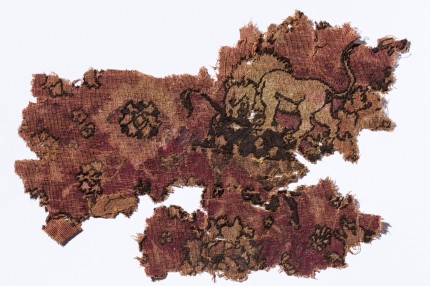The 17th century ship that sank in the Wadden Sea near the island of Texel off the coast of North Holland has already yielded a remarkable trove of well-preserved textiles. A beautiful silk damask gown was identified as having belonged to Jean Kerr, Countess of Roxburghe, lady-in-waiting to Queen Henrietta Maria and governess to three of her children with King Charles I. Buried under the sand for centuries, the gown survived in stunning condition, as did some of her other garments — a jacket, several silk bodices embroidered with gold and silver thread, woven silk knee socks — and pieces like a silver-embroidered red velvet pouch that would normally have disintegrated over time.
Now to that record we can add 13 fragments from an extremely rare carpet. Woven from silk and wool, the carpet has intricate flower and animal designs. One fragment features a striking scene of a lion attacking a cow.

Art historians have studied the fragments, examining the weaving and knotting techniques, the colors, patterns and figures. They believe the carpet was likely manufactured in Lahore, then part of the Mughal Empire that ruled over modern-day Pakistan, India, Afghanistan and Bangladesh. It dates to the second quarter of the 17th century, a time when the Dutch East India Company’s exports of Indian textiles to Europe was kicking into high gear.
Since the ship was a baggage ship for Queen Henrietta Maria’s royal retinue, the carpet may or may not have originated from the Dutch East India Company. The company traded all over Europe, and several Mediterranean objects were found on the wreck, so the carpet might have come to Holland via the south as well.
The highly prized carpets with their stylized botanicals and dynamic animal figures were very popular among the wealthy in the Dutch Golden Age. Yet, almost none of them have survived.
“It’s almost like having the fragments of an original Rembrandt in front of you,” textile researchers Ebeltje Hartkamp-Jonxis and Hillie Smit, who examined the carpet, said in an emailed statement from the museum.
The fragments are now on display at the at the Kaap Skil museum, where the damask dress is on display, in Diving into Details, an exhibition about the latest research into the shipwreck. The exhibition runs through mid-February, after which the fragments will be sent to the Hilde House in Castricum, the archaeological museum of the Province Noord-Holland, for further study and conservation.
Wow! Another amazing post. Thanks for all the work you do to bring us the most interesting and latest discoveries. I read many blogs but yours is the only one I read EVERY DAY. Merry Christmas and Happy Holidays to you!
I second your comment. I save The History Blog for “dessert” after all the god bloody awful news. Peace on earth. Good will toward men.
A recent article in the Dutch newspaper “De Volkskrant” stated that the researchers currently working on the wreck concluded that it actually is a Dutch mercheant ship, and the dress did not belong to Jean Kerr.
volkskrant science
Those are enticing fragments. I so want to take a magnifying glass to them! I am pondering the likely hood of my getting to the exhibit and have come to the conclusion that it is highly unlikely. So will have to look for high res photos. I want to see the knots, darn it! Happy Solstice season, Livius. And thank you for this, and for all the other tidbits of history that help us remember where we came from and what we are capable of.